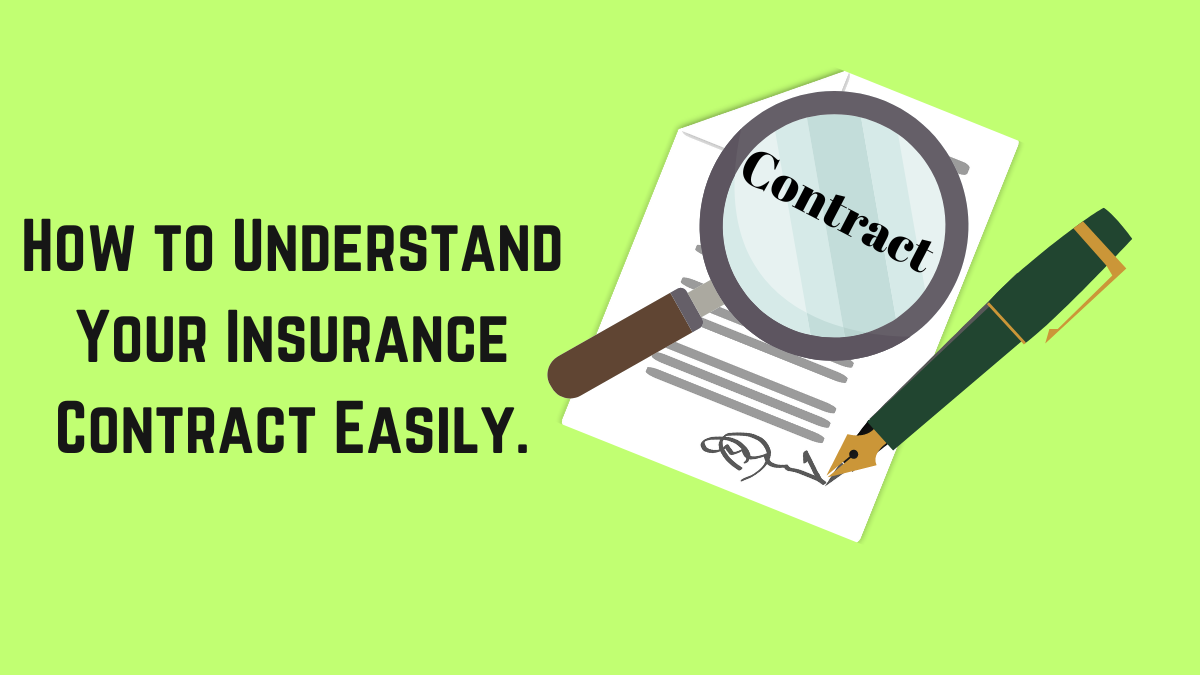Insurance contracts can seem daunting at first glance. With all the legal jargon, complex terms, and fine print, it’s easy to feel overwhelmed. However, understanding your insurance contract is crucial for ensuring that you’re adequately covered and that you know what to expect when you need to file a claim. In this article, we’ll break down the essential components of an insurance contract, helping you to navigate the document with confidence and clarity.
The Basics of an Insurance Contract
Offer and Acceptance
At the heart of every insurance contract is the concept of offer and acceptance. This process begins when you apply for insurance by submitting a proposal form to the insurance company. This submission constitutes your offer to the insurer. The insurance company reviews your application, and if they agree to provide coverage, they accept your offer. Sometimes, the insurer might make changes to your proposed terms before accepting. It’s essential to understand that the contract becomes legally binding only after the insurance company accepts your offer.
ALSO READ: 7 Stocks That Performs Well During a Recession.
Consideration in Insurance Contracts
Consideration refers to what each party gives up in exchange for the agreement. For you, the policyholder, consideration typically comes in the form of premium payments. You pay these premiums to maintain your coverage. For the insurer, consideration is the promise to pay out claims if a covered event occurs. Understanding this mutual exchange is key to grasping how insurance contracts function.
Legal Capacity and Legal Purpose
To enter into a legally binding insurance contract, both parties must have the legal capacity to do so. In simple terms you have to be of legal age and mentally capable.Similarly, the insurer must be licensed and operate within the legal framework of the region. The contract must also have a legal purpose; if it promotes illegal activities, it is automatically void.
ALSO READ: 9 Best Growth Stocks to Hold for the Next Decade.
Understanding Contract Values
Indemnity Contracts
Most insurance contracts are indemnity contracts, meaning they are designed to compensate for actual losses. The indemnification concept makes sure you’re put back in the same financial situation you were in before to the loss, but not better. For example, if your car is stolen, the insurance will cover its value, but you won’t profit from the incident.
Principle of Indemnity
This principle is a cornerstone of indemnity contracts. It dictates that the insurer pays no more than the actual loss suffered. This is to prevent policyholders from profiting from their insurance coverage. For instance, if your old car is insured and gets damaged, you cannot expect the insurer to replace it with a brand-new luxury vehicle. The compensation will only cover the market value of the car at the time of the loss.
ALSO READ: Top 10 High-Performing ETFs to Invest in 2024.
Under-Insurance
Under-insurance occurs when the insured amount is less than the actual value of the insured item. While it might be tempting to save on premiums by insuring your property for less than its worth, this can backfire in the event of a claim. If your house is insured for $80,000 but is worth $100,000, the insurance company will only cover a proportion of any loss, leaving you to cover the rest.
Excess and Deductibles
Excess, also referred to as a deductible, is the total amount you have to pay out of pocket prior to the start of your insurance coverage. For example, if your auto insurance has an excess of $5,000 and you suffer a loss of $7,000, your insurer will only pay $2,000. If the loss is less than $5,000, you bear the full cost. Higher deductibles typically mean lower premiums, but they also mean more risk for you in the event of a claim.
Non-Indemnity Contracts
Unlike indemnity contracts, non-indemnity contracts do not focus on compensating for actual financial loss. Life insurance is a prime example. You can’t put a monetary value on a person’s life, so these policies pay out a predetermined amount, regardless of the actual financial loss.
Declarations Page
The declarations page is often the first page of a life insurance policy and includes crucial information such as the policyholder’s name, policy number, and coverage details. It also specifies the beneficiaries, who will receive the payout upon the policyholder’s death.
ALSO READ: Top Low-Risk, High-Return Investment Strategies for Retirees.
Coverage Details
This section outlines the specifics of the coverage, including premium amounts, payment schedules, and any penalties for missed payments. Understanding this section is vital for knowing exactly what you’re covered for and what your responsibilities are.
Additional Policy Details
Life insurance contracts often come with additional options, known as riders, which can expand your coverage. Common riders include accelerated death benefits, which allow you to access part of the death benefit early if you are diagnosed with a terminal illness. These additions can be tailored to meet your specific needs, but they also come at an additional cost.
Insurable Interest
Insurable interest is a fundamental principle of insurance. It means that you can only insure something if you would suffer a financial loss or legal liability if it were damaged or lost. For example, you can insure your own house, but not your neighbor’s, because you don’t have a financial stake in their property. In life insurance, this principle allows spouses to insure each other’s lives, recognizing the financial impact that one partner’s death would have on the other.
The Doctrine of Subrogation
Subrogation allows an insurance company to pursue a third party that has caused a loss to the insured. If you are in a car accident caused by another driver, your insurance company may pay your claim and then seek reimbursement from the at-fault driver or their insurer. This helps the insurance company recover some of the money it has paid out on your behalf.
The Doctrine of Good Faith
Insurance contracts are built on the principle of uberrima fides, or utmost good faith. Both you and the insurer must act honestly and disclose all relevant information when entering into a contract. For you, this means providing accurate details about the risk being insured, such as your medical history when applying for life insurance. For the insurer, it means being transparent about the terms of coverage and the risks they are willing to cover.
Duty of Disclosure
Your duty of disclosure requires you to provide all material facts that could influence the insurer’s decision to offer coverage. For example, if you are a smoker applying for life insurance, you must disclose this information, as it significantly affects your risk profile. Failure to disclose important facts can lead to the cancellation of your policy or denial of a claim.
Representations and Warranties
When you apply for insurance, you make representations—statements that should be true to the best of your knowledge. If these statements are found to be false, the insurer may have grounds to void the contract. Warranties, on the other hand, are promises that certain conditions will be met throughout the policy’s life. For instance, in auto insurance, if you state that only licensed drivers will operate your vehicle, this becomes a warranty. If someone without a license drives your car and gets into an accident, the insurer could deny your claim due to a breach of warranty.
Other Policy Aspects
Doctrine of Adhesion
The doctrine of adhesion means that you must accept the insurance contract as is, without negotiating its terms. If there’s any ambiguity in the contract, it will typically be interpreted in favor of the insured, because the insurer is the one who drafted the document.
Waiver and Estoppel
A waiver occurs when the insurer voluntarily gives up a right, such as the right to void a policy due to non-disclosure. Estoppel prevents the insurer from later asserting that right if they acted as though it didn’t exist. For example, if your insurer issues a policy without asking for certain information, they may be estopped from denying a claim based on that information later.
Endorsements, Co-Insurance, and Reinsurance
Endorsements
Endorsements are amendments to the original policy that can add or modify coverage. For instance, you might add a rider to your home insurance to cover expensive jewelry or art. It’s crucial to review these endorsements to ensure they meet your needs.
Co-Insurance
In co-insurance, you and the insurance provider share the risk. This is common in health insurance, where you might agree to cover 20% of medical costs while the insurer covers the remaining 80%. Understanding your co-insurance obligations helps you avoid unexpected expenses.
Reinsurance
Reinsurance occurs when an insurance company spreads its risk by sharing it with another insurer. This is more common with large policies or those involving significant risks, such as insuring a celebrity’s voice. While reinsurance doesn’t directly affect you, it’s good to know that insurers manage their risks to ensure they can cover large claims.
Conclusion
Understanding your insurance contract is essential to ensuring that you are adequately protected when you need it most. By familiarizing yourself with the basics, such as offer and acceptance, consideration, and the various doctrines that govern insurance, you can make informed decisions and avoid unpleasant surprises. Always read your policy thoroughly, ask questions if something is unclear, and consult with your insurance advisor to ensure you have the coverage that best suits your needs.
FAQs
- What is the difference between an indemnity contract and a non-indemnity contract?
- An indemnity contract compensates for actual financial losses, while a non-indemnity contract, like life insurance, pays a predetermined amount regardless of the actual loss.
- What happens if I don’t disclose all relevant information when applying for insurance?
- Failure to disclose important information can lead to the cancellation of your policy or denial of claims. This is known as a breach of the duty of disclosure.
- Can I negotiate the terms of my insurance contract?
- Generally, no. Insurance contracts are adhesion contracts, meaning you must accept the terms as written. However, you can choose to add endorsements or riders to customize your coverage.
- What does an insurance policy’s deductible mean?
- The amount you have to pay out-of-pocket before your insurance coverage begins is known as your deductible.
- How does subrogation benefit the insurance company?
- Subrogation allows the insurance company to recover the money it paid out on a claim by pursuing the responsible third party, helping to offset their costs.










